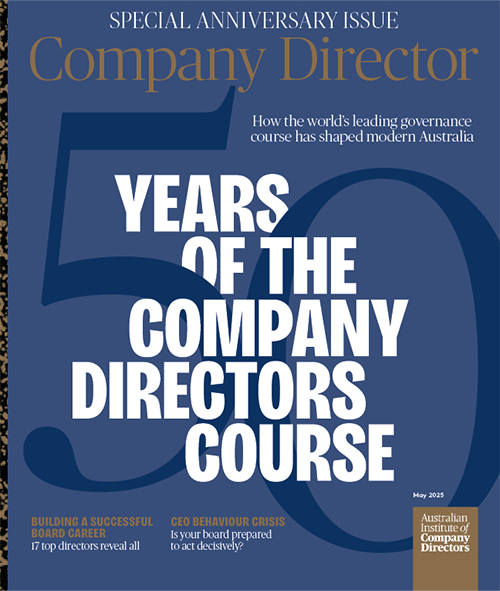It’s widely accepted that to manage risk, innovate and be productive, organisations need to facilitate a healthy workplace culture — and a healthy culture begins with the board.
Many boards are zooming in on culture more than ever before, spurred into action for a multitude of compelling reasons, from regulatory scrutiny to a workforce revolutionised by a global pandemic. Social movements like MeToo and Black Lives Matter have sharpened the focus on culture, along with the imperative for stellar environmental, social and governance (ESG) credentials with an increasing emphasis on the “S”, observes former Sex Discrimination Commissioner Elizabeth Broderick AO.
Whether it’s through the eyes of investors, the community, shareholders or employees, Broderick sees “a growing understanding that harmful behaviours in the workplace translate into financial impact for companies”.
Broderick is the founder of Champions of Change, a former UN Special Rapporteur on discrimination against women and these days a culture renewal consultant to many of Australia’s top organisations. “Like the operating system in a computer, culture is the enabling environment for everything an organisation does,” she says.
Once seen as an add-on or solely the purview of management, the importance of a psychologically safe workplace and a healthy human culture for organisations is clear, even before you get to the business case for boosting innovation and productivity or managing risk. And a healthy culture, says Broderick, starts with the board.
Recent research from Culture Amp shows boards are taking a proactive approach. Some 70 per cent of ASX 200 companies have people and culture committees mustering the critical function of organisational culture, which hangs on one of the greatest variables of all — human behaviour.
The Melbourne-based employee experience platform (with 1.3 billion data points on the topic) is keeping tabs on dynamic trends. Right now, performance and attrition are in sharp focus across industries because companies are capital- constrained, reports Justin Angsuwat, chief people officer at Culture Amp. He talks to people and culture committees about “looking through the windshield and not through the rearview mirror” — the need to be proactive. “Australian data shows one in five people are planning to leave their jobs in the next 12 months — but less than one in five are actually leaving right now,” he says. “So, there’s a pent-up demand to go that’s driving companies to take action.”
Data insights, analytics and artificial intelligence (AI), with tools like organisational heat maps, are enabling what boards and leadership teams can see and do.
But data alone is not a fix, says Angsuwat. “Blind spots can occur if you’re trying to find the perfect answer in a sea of information on culture.”
That said, it can highlight where to look for high performance or trouble spots in your company so you can take action — and actionable insights are surfaced with the help of in-house or external teams.
“Culture is certainly measurable, directly and indirectly,” concurs Broderick.
Organisations typically start with metrics from engagement surveys, but in the quest for predictive indicators and proactivity, there’s much more to consider. Listening to the human stories tops the list for Broderick, who has worked with some of Australia’s biggest organisations, including Rio Tinto and the Australian Federal Police.
Future-proofing a healthy corporate culture means building it into the DNA of the organisation, says Broderick (pictured, above).
Wiring in culture
Transformation through “the wiring” of the organisation is top of mind for Alexandra Taylor GAICD, chief people officer at the Bank of Queensland (BOQ), where the significance of culture is flagged by the whole-of-board representation on its people, culture and remuneration committee. The committee’s meetings often run in parallel with general board meetings, eight or nine times a year. This holistic priority for culture across the board gives uplift to the effectiveness of Taylor and her team of 100 among the bank’s 3500 employees.
It has been a year of change for the BOQ workforce. In August, the bank announced it would undertake staff cuts of up to 400 full-time equivalent roles to “streamline its operating model as part of its ongoing transformation”. A cultural reset became a priority when the board revisited its bank-wide strategy in May. Since then, BOQ has undertaken a gap analysis and defined three key elements to prioritise. These included “Customer first”, “Performance excellence for sustainable outcomes” and “Size is our superpower”. The latter of which is a phrase coined by a senior leader that has resonated strongly.
“As a mid-tier bank, our size should help us be more nimble, more agile and operate more simply,” says Taylor.
Keeping track of these attributes is a new culture index that feeds into the group scorecard.
That will be how the board assesses BOQ’s culture — and how CEO Patrick Allaway and the executive are assessed.
The “secret sauce” for driving performance across the bank, says Taylor, comes from embedding those attributes into the governance. “Everything needs to reflect the cultural attributes we want our people to have, from the way they are recruited and developed to their performance and reward/remuneration, how we deliver and embed change (such as new technologies for customers and employees) and their decision-making with our customers in day-to-day interactions.”
Messaging on culture also comes from the board and the CEO, amplified in town hall and senior leaders’ meetings and all-hands conversations. Constant culture reinforcement has proved the most effective strategy. “A campaign- style communication approach may create a really strong burst this month, but might be hard to sustain on an ongoing basis”, says Taylor.
Unifying factors
Lucia Cade FAICD, chair of the people and governance committee at Engineers Australia (EA), sees power in messaging. She says what’s on the board and committee agenda alone serves as a strong message about priorities to the business.
The professional body unifies its culture with the bold purpose of “advancing society through great engineering”. A “one EA” approach to culture is vital for aligning the diverse skills and perspectives of more than 120,000 members, many divisions, colleges, technical societies, 300-plus staff and more than 2500 volunteers.
Key items on the committee’s agenda are diversity and inclusion. “We don’t attract enough women into the profession — and we don’t keep them,” says Cade.
Similarly, on the international front, more than 60 per cent of engineers working in Australia have been trained overseas. However, as Cade notes, “a lot of trained engineers are pulling coffees and driving Ubers”.
Consequently, while the organisation works with educational institutions and employers to boost opportunities, gender and inclusion policies cover recruitment selection panels, shortlists and career development. Talent mapping is tracked.
The committee is also proactive on succession planning. “We do a mix of selection and election, and tap people on the shoulder for leadership roles, so we don’t just rely on people to put their hands up,” she says.
Cade, a former president of the Australian Water Association — whose board portfolio encompasses infrastructure, waste recycling, energy research and investment — says there are universal essentials when it comes to measuring and tracking culture. There’s a strong correlation between regular feedback and future high performance. Engagement is one.
“From the perspective of chairing a people and culture committee and a board, I want to know that regular formal feedback sessions between leaders and their people are happening,” says Cade. “That is one of the reportable lead metrics we have at Energy Australia.”
Fast action
Facing into the future was inevitable for Raj Tapper MAICD, appointed as the first head of people and culture at Clemenger Group in 2021. She was handed a blank slate for developing policies and processes for the group’s 20 marketing and communications agencies as the disruption of the pandemic and extreme talent shortages raged.
The clout attached to her role was also strongly signalled by her appointment to the board, where the risk committee now includes people and culture in its scope. Tapper’s challenge was to identify programs of work that would lift the game for all agencies despite their different purposes and outputs — advertising, public relations, government relations, data analytics, research and tech transformation, to name a few.
At the same time, each agency needed to autonomously manage its own unique culture.
There was low-hanging fruit in the senior ranks of the male-dominated advertising industry. Likewise in leadership development, because experiences largely “had been influenced by leaders who’d had to make it up as they’d gone along”, says Tapper. Lagging indicators ruled at the 75-year-old organisation.
“Everything that was known about how people felt came from exit interviews,” she says.
However, something powerful happened when agencies became accountable. With the help of an engagement survey, they started reporting their metrics for employee engagement, gender pay gap, gender diversity and turnover.
Tapper and her team of eight, plus four recruitment specialists, have already notched up several achievements that demonstrate how quickly culture can shift. At 46 per cent, Clemenger Group now sits just shy of its target of 50 per cent females in senior roles by 2025. The company’s gender pay gap is better than industry average and it is also over-indexing on females for development opportunities.
A consistent approach to leadership development at Clemenger is also in place across Australia and New Zealand, while performance management takes the form of goal-setting.
“It’s amazing how impactful and positive people can be with a clear direction,” says Tapper. “They know where the organisation is going and where they’re going as part of that.”
The architecture of the employee engagement survey helps to predict why people might leave. “But it’s also about taking the time to understand what matters to people inside and outside of work,” says Tapper. “No spreadsheet can do that.”
So, what’s next? A recent program of work to foster collaboration across the group has been introduced, and wellbeing is a major agenda item with mental health coming to the fore as an industry-wide issue.
“Data shows people are anxious about the cost of living, geopolitics and the US election,” she says. “And we haven’t really shaken off COVID yet.”
All Clemenger Group’s senior leaders are now being trained in psychosocial health, says Tapper noting that Australia has been one of the first countries to enact legislation to put mental wellbeing on the radar. She adds that mental health first aiders have also recently been appointed across the group.
This article first appeared under the headline 'Cultural Revolution’ in the November 2024 issue of Company Director magazine.
Latest news
Already a member?
Login to view this content



